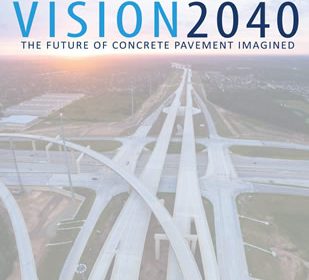The American Concrete Pavement Association’s new 16-page treatise, “VISION2040: The Future of Concrete Pavement Imagined,” provides a glimpse of transportation policy, planning and project execution over the next 20 years. Authors describe anticipated agency or project owner needs; forecast how rigid pavements will serve various functions; explain how the association and allies will shape the future; and, indicate the great potential for infrastructure safety, performance and value if stakeholders invest and collaborate effectively along the way.
|
|
| Report is posted at www.acpa.org. |
To develop a snapshot of what transportation and concrete pavements will look like as the industry approaches 2040, ACPA convened a “blue-ribbon” panel of 25 experts representing transportation agencies or project owners, academia, plus concrete production and pavement interests. Against the backdrop of a projected 2018–2040 U.S. population gain of 70 million, coupled with a 40 percent-plus climb in freight over present volume, the panel assessed such factors as increasing truck traffic and heavier loads; autonomous vehicles; e-commerce and distribution of goods; dedicated freight network possibilities; and, alternative roadway ownership models.
 |
 |
| Reconstruction of Wisconsin State Highway 42 took the Municipal Streets & Intersections (< 30,000 sq. yd.) Gold Award in the American Concrete Pavement Association 2018 Excellence in Concrete Pavements Awards, recognizing Vinton Construction Co.; McMahon Group, engineer; and, Wisconsin Department of Transportation and City of Two Rivers. The typical pavement section consisted of 6-in. dense aggregate base and 8-in. jointed concrete pavement with dowels. Zero-clearance pavers and belt placers allowed mainline concrete to be placed without sacrificing pedestrian access. |
 |
| PHOTOS: American Concrete Pavement Association |
“By 2040, most of the U.S. population will live in megaregions comprised of urban areas surrounded by growing suburban and exurban areas. Urban areas will transform as livable communities with more flexible mobility options, and roadways will be increasingly designed to integrate into this environment,” VISION2040 authors observe. “Pavements will serve more purposes than just being transportation surfaces. By 2040, technology will lead to ‘complete streets,’ which use pavements as a platform to store energy, generate electricity and treat water. Smart highway/roadway pavement integration with smart vehicles will enhance vehicle-roadway connectivity for safety, lane optimization and less traffic congestion.”
“Agencies will require solutions that extend pavement service life in a cost-effective, sustainable way, and in a manner that better capitalizes on the equity in the existing roadway structure,” they add. “Pavement material durability and longevity will be an even more important consideration than it is today. Agencies will increasingly demand solutions that require fewer interventions for resurfacing, rehabilitation or replacement and the traffic disruption that accompanies these activities. By 2040, agencies will regularly apply life-cycle assessment tools to help document the economic, environmental and societal impact of their roadway assets.”
Blue ribbon panel members included ACPA President Jerry Voigt, 2017 Chairman Lori Tiefenthaler (Lehigh Hanson Inc.) and 2019 Chairman James Mack (Cemex USA); Concrete Sustainability Hub at MIT Executive Director Jeremy Gregory; and, Kevin Klein of Gomaco Corp.
